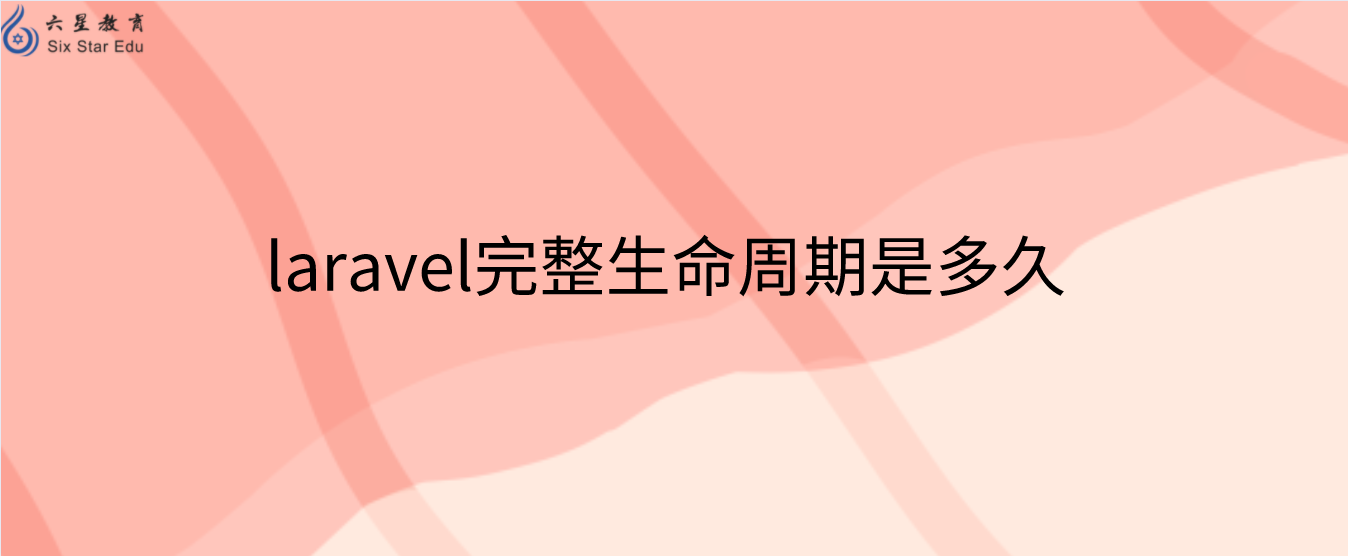
雖然關(guān)于 laravel 的生命周期的文章已經(jīng)很多了,但是也很有必要根據(jù)自己的理解分享出一篇文章來,加深下印象。
簡(jiǎn)介
Laravel的生命周期開始于 public/index.php,結(jié)束于 public/index.php。客戶端的所有請(qǐng)求都經(jīng)由Web服務(wù)器引導(dǎo)到這個(gè)文件中。以下是public/index.php 文件的源碼和注釋:
#public/index.php 文件
// 定義了laravel一個(gè)請(qǐng)求的開始時(shí)間
define('LARAVEL_START', microtime(true));
// composer自動(dòng)加載機(jī)制,加載項(xiàng)目依賴
require __DIR__.'/../vendor/autoload.php';
// 這句話你就可以理解laravel,在最開始引入了一個(gè)ioc容器。
$app = require_once __DIR__.'/../bootstrap/app.php';
// 這個(gè)相當(dāng)于我們創(chuàng)建了Kernel::class的服務(wù)提供者
$kernel = $app->make(Illuminate\Contracts\Http\Kernel::class);
// 獲取一個(gè) Request ,返回一個(gè) Response。以把該內(nèi)核想象作一個(gè)代表整個(gè)應(yīng)用的大黑盒子,輸入 HTTP 請(qǐng)求,返回 HTTP 響應(yīng)
// 處理請(qǐng)求
$response = $kernel->handle(
// 創(chuàng)建請(qǐng)求實(shí)例
$request = Illuminate\Http\Request::capture()
);
// 發(fā)送響應(yīng),就是把我們服務(wù)器的結(jié)果返回給瀏覽器。
$response->send();
// 終止程序,這個(gè)就是執(zhí)行我們比較耗時(shí)的請(qǐng)求,
$kernel->terminate($request, $response);
由上可知 Laravel 的生命周期分為以下3個(gè)主要階段:
?加載項(xiàng)目依賴。
?創(chuàng)建Laravel應(yīng)用實(shí)例
?接收請(qǐng)求并響應(yīng)。
接下來我們根據(jù) public/index.php 文件,開始 Laravel 的生命周期之旅吧!
一、Composer 自動(dòng)加載項(xiàng)目依賴
// composer自動(dòng)加載機(jī)制 require __DIR__.'/../vendor/autoload.php';
Composer 是 PHP 的包管理器,用來管理項(xiàng)目依賴的工具,autoload.php 中引入了 Composer 自動(dòng)生成的加載程序,實(shí)現(xiàn)加載第三方依賴。
autoload.php 文件代碼:
// autoload.php @generated by Composer require_once __DIR__ . '/composer/autoload_real.php'; return ComposerAutoloaderInit101671ca9bbc2f62f8335eb842637291::getLoader();
二、創(chuàng)建應(yīng)用實(shí)例
$app = require_once __DIR__.'/../bootstrap/app.php';
bootstrap/app.php 文件代碼:
// 創(chuàng)建Laravel應(yīng)用的ioc容器,
$app = new Illuminate\Foundation\Application(
$_ENV['APP_BASE_PATH'] ?? dirname(__DIR__)
);
// 完成內(nèi)核的綁定
$app->singleton(
Illuminate\Contracts\Http\Kernel::class,
App\Http\Kernel::class
);
$app->singleton(
Illuminate\Contracts\Console\Kernel::class,
App\Console\Kernel::class
);
$app->singleton(
Illuminate\Contracts\Debug\ExceptionHandler::class,
App\Exceptions\Handler::class
);
// 返回實(shí)例
return $app;
如果你理解了 Ioc(控制反轉(zhuǎn)),那么對(duì)于以上代碼你一定很熟悉。
Ioc 容器(服務(wù)容器) 是 Laravel 的核心,這一階段主要實(shí)現(xiàn)了 2大功能:
1、創(chuàng)建容器
2、綁定內(nèi)核
創(chuàng)建容器
$app = new Illuminate\Foundation\Application( $_ENV['APP_BASE_PATH'] ?? dirname(__DIR__) );
我們進(jìn)入 Illuminate\Foundation\Application 容器中,以下是構(gòu)造函數(shù)的分析:
/**
* Create a new Illuminate application instance.
*
* @param string|null $basePath
* @return void
*/
public function __construct($basePath = null)
{
if ($basePath) {
// 1、路徑綁定
$this->setBasePath($basePath);
}
// 2、基礎(chǔ)綁定
$this->registerBaseBindings();
// 3、基礎(chǔ)服務(wù)提供者綁定(事件,日志,路由)
$this->registerBaseServiceProviders();
// 4、核心別名綁定,目的是給核心的類命名空間設(shè)置別名,以便后續(xù)使用
$this->registerCoreContainerAliases();
}
綁定內(nèi)核
// 完成內(nèi)核的綁定 // HTTP內(nèi)核 $app->singleton( Illuminate\Contracts\Http\Kernel::class, App\Http\Kernel::class ); // Console內(nèi)核 $app->singleton( Illuminate\Contracts\Console\Kernel::class, App\Console\Kernel::class ); // 綁定異常處理 $app->singleton( Illuminate\Contracts\Debug\ExceptionHandler::class, App\Exceptions\Handler::class );
在 Laravel 中只要是通過 public/index.php 來啟動(dòng)框架的,都會(huì)用到 Http Kernel(主要作用就是接受請(qǐng)求并返回響應(yīng)),而其他的例如通過 artisan 命令、計(jì)劃任務(wù)、隊(duì)列等啟動(dòng)框架進(jìn)行處理的都會(huì)用到 Console 內(nèi)核。
其中 HTTP 內(nèi)核類繼承 Illuminate\Foundation\Http\Kernel ,HTTP內(nèi)核類中定義了中間件相關(guān)數(shù)組,中間件主要是提供了一種方便機(jī)制用來過濾進(jìn)入應(yīng)用的請(qǐng)求和處理HTTP響應(yīng)。
HTTP 內(nèi)核類:
<?php
namespace App\Http;
use Illuminate\Foundation\Http\Kernel as HttpKernel;
class Kernel extends HttpKernel
{
/**
* The application's global HTTP middleware stack.
*
* These middleware are run during every request to your application.
*
* @var array
*/
protected $middleware = [
\App\Http\Middleware\TrustProxies::class,
\App\Http\Middleware\CheckForMaintenanceMode::class,
\Illuminate\Foundation\Http\Middleware\ValidatePostSize::class,
\App\Http\Middleware\TrimStrings::class,
\Illuminate\Foundation\Http\Middleware\ConvertEmptyStringsToNull::class,
];
/**
* The application's route middleware groups.
*
* @var array
*/
protected $middlewareGroups = [
'web' => [
\App\Http\Middleware\EncryptCookies::class,
\Illuminate\Cookie\Middleware\AddQueuedCookiesToResponse::class,
\Illuminate\Session\Middleware\StartSession::class,
// \Illuminate\Session\Middleware\AuthenticateSession::class,
\Illuminate\View\Middleware\ShareErrorsFromSession::class,
\App\Http\Middleware\VerifyCsrfToken::class,
\Illuminate\Routing\Middleware\SubstituteBindings::class,
],
'api' => [
'throttle:60,1',
'bindings',
],
];
/**
* The application's route middleware.
*
* These middleware may be assigned to groups or used individually.
*
* @var array
*/
protected $routeMiddleware = [
'auth' => \App\Http\Middleware\Authenticate::class,
'auth.basic' => \Illuminate\Auth\Middleware\AuthenticateWithBasicAuth::class,
'bindings' => \Illuminate\Routing\Middleware\SubstituteBindings::class,
'cache.headers' => \Illuminate\Http\Middleware\SetCacheHeaders::class,
'can' => \Illuminate\Auth\Middleware\Authorize::class,
'guest' => \App\Http\Middleware\RedirectIfAuthenticated::class,
'signed' => \Illuminate\Routing\Middleware\ValidateSignature::class,
'throttle' => \Illuminate\Routing\Middleware\ThrottleRequests::class,
'verified' => \Illuminate\Auth\Middleware\EnsureEmailIsVerified::class,
];
/**
* The priority-sorted list of middleware.
*
* This forces non-global middleware to always be in the given order.
*
* @var array
*/
protected $middlewarePriority = [
\Illuminate\Session\Middleware\StartSession::class,
\Illuminate\View\Middleware\ShareErrorsFromSession::class,
\App\Http\Middleware\Authenticate::class,
\Illuminate\Session\Middleware\AuthenticateSession::class,
\Illuminate\Routing\Middleware\SubstituteBindings::class,
\Illuminate\Auth\Middleware\Authorize::class,
];
}
HTTP內(nèi)核類的父類:Illuminate\Foundation\Http\Kernel 提供了名為 $bootstrappers 的引導(dǎo)程序數(shù)組,包括了環(huán)境檢測(cè)、加載配置、處理異常、Facades注冊(cè)、服務(wù)提供者注冊(cè)、啟動(dòng)服務(wù)這6個(gè) 程序。
/**
* The bootstrap classes for the application.
*
* @var array
*/
protected $bootstrappers = [
\Illuminate\Foundation\Bootstrap\LoadEnvironmentVariables::class,
\Illuminate\Foundation\Bootstrap\LoadConfiguration::class,
\Illuminate\Foundation\Bootstrap\HandleExceptions::class,
\Illuminate\Foundation\Bootstrap\RegisterFacades::class,
\Illuminate\Foundation\Bootstrap\RegisterProviders::class,
\Illuminate\Foundation\Bootstrap\BootProviders::class,
];
Console 內(nèi)核:
一個(gè)健壯的應(yīng)用程序除了滿足網(wǎng)絡(luò)請(qǐng)求外,還應(yīng)該包括執(zhí)行計(jì)劃任務(wù)、異步隊(duì)列等,Laravel中通過artisan工具定義各種命令來完成非 HTTP 請(qǐng)求的各種場(chǎng)景。artisan命令通過 Laravel 的 Console 內(nèi)核完成對(duì)應(yīng)用核心組件的調(diào)度來完成任務(wù)。Console 內(nèi)核在這不做詳細(xì)介紹。
綁定異常處理
異常處理由 App\Exceptions\Handler 類完成,所有的異常處理都由其處理,在這里同樣不做詳細(xì)介紹。
三、接收請(qǐng)求并響應(yīng)
解析內(nèi)核
$kernel = $app->make(Illuminate\Contracts\Http\Kernel::class);
這里將 HTTP 內(nèi)核解析出來,我們進(jìn)一步查看Illuminate\Contracts\Http\Kernel::class 的內(nèi)部代碼,
構(gòu)造函數(shù)中注入了app容器和路由器2個(gè)函數(shù),在實(shí)例化內(nèi)核的過程中,將內(nèi)核中定義的中間件注冊(cè)到路由器中,注冊(cè)完成后便可以處理HTTP請(qǐng)求前調(diào)用中間件 實(shí)現(xiàn)過濾請(qǐng)求的目的。
Illuminate\Foundation\Http\Kernel 的構(gòu)造函數(shù):
/**
* Create a new HTTP kernel instance.
*
* @param \Illuminate\Contracts\Foundation\Application $app
* @param \Illuminate\Routing\Router $router
* @return void
*/
public function __construct(Application $app, Router $router)
{
$this->app = $app;
$this->router = $router;
$router->middlewarePriority = $this->middlewarePriority;
foreach ($this->middlewareGroups as $key => $middleware) {
$router->middlewareGroup($key, $middleware);
}
foreach ($this->routeMiddleware as $key => $middleware) {
$router->aliasMiddleware($key, $middleware);
}
}
// Illuminate\Routing\Router 類中
/**
* Register a group of middleware.
*
* @param string $name
* @param array $middleware
* @return $this
*/
public function middlewareGroup($name, array $middleware)
{
$this->middlewareGroups[$name] = $middleware;
return $this;
}
/**
* Register a short-hand name for a middleware.
*
* @param string $name
* @param string $class
* @return $this
*/
public function aliasMiddleware($name, $class)
{
$this->middleware[$name] = $class;
return $this;
}
處理 HTTP 請(qǐng)求
// handle 方法處理請(qǐng)求 $response = $kernel->handle( // 創(chuàng)建請(qǐng)求實(shí)例 $request = Illuminate\Http\Request::capture() );
創(chuàng)建請(qǐng)求實(shí)例:在處理請(qǐng)求過程之前會(huì)通過 Illuminate\Http\Request 的 capture 方法,以進(jìn)入應(yīng)用的HTTP請(qǐng)求信息為基礎(chǔ),創(chuàng)建出一個(gè) Laravel Request請(qǐng)求實(shí)例,在后續(xù)應(yīng)用剩余的生命周期中Request請(qǐng)求實(shí)例就是對(duì)本次HTTP請(qǐng)求的抽象。
/**
* Create a new Illuminate HTTP request from server variables.
*
* @return static
*/
public static function capture()
{
static::enableHttpMethodParameterOverride();
return static::createFromBase(SymfonyRequest::createFromGlobals());
}
/**
* Creates a new request with values from PHP's super globals.
*
* @return static
*/
public static function createFromGlobals()
{
$request = self::createRequestFromFactory($_GET, $_POST, [], $_COOKIE, $_FILES, $_SERVER);
if (0 === strpos($request->headers->get('CONTENT_TYPE'), 'application/x-www-form-urlencoded')
&& \in_array(strtoupper($request->server->get('REQUEST_METHOD', 'GET')), ['PUT', 'DELETE', 'PATCH'])
) {
parse_str($request->getContent(), $data);
$request->request = new ParameterBag($data);
}
return $request;
}
handle 處理請(qǐng)求:將 HTTP 請(qǐng)求抽象成 Laravel Request 請(qǐng)求實(shí)例后,請(qǐng)求實(shí)例會(huì)被傳導(dǎo)進(jìn)入到HTTP內(nèi)核的 handle 方法內(nèi)部,請(qǐng)求的處理就是由 handle 方法來完成的。
namespace Illuminate\Foundation\Http;
class Kernel implements KernelContract
{
/**
* Handle an incoming HTTP request.
*
* @param \Illuminate\Http\Request $request
* @return \Illuminate\Http\Response
*/
public function handle($request)
{
try {
$request->enableHttpMethodParameterOverride();
$response = $this->sendRequestThroughRouter($request);
} catch (Exception $e) {
$this->reportException($e);
$response = $this->renderException($request, $e);
} catch (Throwable $e) {
$this->reportException($e = new FatalThrowableError($e));
$response = $this->renderException($request, $e);
}
$this->app['events']->dispatch(
new Events\RequestHandled($request, $response)
);
return $response;
}
}
handle 方法接收了一個(gè)請(qǐng)求,并在最后返回了一個(gè) HTTP響應(yīng)。
接下來進(jìn)入 sendRequestThroughRouter 方法,通過中間件/路由器發(fā)送給定的請(qǐng)求。
該方法的程序執(zhí)行如下:
1、將 request 請(qǐng)求實(shí)例注冊(cè)到 app 容器當(dāng)中
2、清除之前的 request 實(shí)例緩存
3、啟動(dòng)引導(dǎo)程序:加載內(nèi)核中定義的引導(dǎo)程序來引導(dǎo)啟動(dòng)應(yīng)用
4、將請(qǐng)求發(fā)送到路由:通過 Pipeline 對(duì)象傳輸 HTTP請(qǐng)求對(duì)象流經(jīng)框架中定義的HTTP中間件和路由器來完成過濾請(qǐng)求,最終將請(qǐng)求傳遞給處理程序(控制器方法或者路由中的閉包)由處理程序返回相應(yīng)的響應(yīng)。
/**
* Send the given request through the middleware / router.
*
* @param \Illuminate\Http\Request $request
* @return \Illuminate\Http\Response
*/
protected function sendRequestThroughRouter($request)
{
$this->app->instance('request', $request);
Facade::clearResolvedInstance('request');
$this->bootstrap();
return (new Pipeline($this->app))
->send($request)
->through($this->app->shouldSkipMiddleware() ? [] : $this->middleware)
->then($this->dispatchToRouter());
}
bootstrap 引導(dǎo)程序
/**
* Bootstrap the application for HTTP requests.
*
* @return void
*/
public function bootstrap()
{
if (! $this->app->hasBeenBootstrapped()) {
$this->app->bootstrapWith($this->bootstrappers());
}
}
/**
* Get the bootstrap classes for the application.
*
* @return array
*/
protected function bootstrappers()
{
return $this->bootstrappers;
}
/**
* The bootstrap classes for the application.
*
* @var array
*/
protected $bootstrappers = [
\Illuminate\Foundation\Bootstrap\LoadEnvironmentVariables::class,
\Illuminate\Foundation\Bootstrap\LoadConfiguration::class,
\Illuminate\Foundation\Bootstrap\HandleExceptions::class,
\Illuminate\Foundation\Bootstrap\RegisterFacades::class,
\Illuminate\Foundation\Bootstrap\RegisterProviders::class,
\Illuminate\Foundation\Bootstrap\BootProviders::class,
];
/*引導(dǎo)啟動(dòng)Laravel應(yīng)用程序
1. DetectEnvironment 檢查環(huán)境
2. LoadConfiguration 加載應(yīng)用配置
3. ConfigureLogging 配置日至
4. HandleException 注冊(cè)異常處理的Handler
5. RegisterFacades 注冊(cè)Facades
6. RegisterProviders 注冊(cè)Providers
7. BootProviders 啟動(dòng)Providers
*/
關(guān)于引導(dǎo)程序的啟動(dòng)原理,有時(shí)間我們?cè)俪槌鰜砜纯础?
發(fā)送響應(yīng)
$response->send();
經(jīng)過了以上階段,終于獲取到了我們想要的數(shù)據(jù),接下來是將數(shù)據(jù)響應(yīng)到客戶端。
程序由在 Illuminate\Http\Response 內(nèi)部由其父類 Symfony\Component\HttpFoundation\Response 的 send() 方法實(shí)現(xiàn)。
/**
* Sends HTTP headers and content.
*
* @return $this
*/
public function send()
{
$this->sendHeaders(); // 發(fā)送頭部信息
$this->sendContent(); // 發(fā)送報(bào)文主題
if (\function_exists('fastcgi_finish_request')) {
fastcgi_finish_request();
} elseif (!\in_array(\PHP_SAPI, ['cli', 'phpdbg'], true)) {
static::closeOutputBuffers(0, true);
}
return $this;
}
四、終止應(yīng)用程序
該過程調(diào)用終止中間件。
響應(yīng)完成后,HTTP 內(nèi)核會(huì)調(diào)用 terminate 中間件做一些后續(xù)的處理工作。比如,Laravel 內(nèi)置的 session 中間件會(huì)在響應(yīng)發(fā)送到瀏覽器之后將會(huì)話數(shù)據(jù)寫入存儲(chǔ)器中。
HTTP 內(nèi)核的 terminate 方法會(huì)調(diào)用 terminate 中間件的 terminate 方法,調(diào)用完成后,整個(gè)生命周期結(jié)束。
$kernel->terminate($request, $response);
/**
* Call the terminate method on any terminable middleware.
*
* @param \Illuminate\Http\Request $request
* @param \Illuminate\Http\Response $response
* @return void
*/
public function terminate($request, $response)
{
$this->terminateMiddleware($request, $response);
$this->app->terminate();
}
/**
* Call the terminate method on any terminable middleware.
*
* @param \Illuminate\Http\Request $request
* @param \Illuminate\Http\Response $response
* @return void
*/
protected function terminateMiddleware($request, $response)
{
$middlewares = $this->app->shouldSkipMiddleware() ? [] : array_merge(
$this->gatherRouteMiddleware($request),
$this->middleware
);
foreach ($middlewares as $middleware) {
if (! is_string($middleware)) {
continue;
}
[$name] = $this->parseMiddleware($middleware);
$instance = $this->app->make($name);
if (method_exists($instance, 'terminate')) {
$instance->terminate($request, $response);
}
}
}
五、總結(jié)
在Laravel 的整個(gè)生命周期中,加載項(xiàng)目依賴、創(chuàng)建應(yīng)用實(shí)例、接收并響應(yīng)請(qǐng)求,終止程序,內(nèi)核都起到了串聯(lián)作用。
首先,創(chuàng)建 Laravel 應(yīng)用程序 階段時(shí),包含了注冊(cè)項(xiàng)目基礎(chǔ)服務(wù)、注冊(cè)項(xiàng)目服務(wù)提供者別名、注冊(cè)目錄路徑、異常類綁定等工作,同時(shí)在HTTP 內(nèi)核中配置了引導(dǎo)程序。接著,在 接收請(qǐng)求并響應(yīng) 階段時(shí),會(huì)根據(jù)運(yùn)行的環(huán)境解析出 HTTP 內(nèi)核或 Console 內(nèi)核。在 HTTP 內(nèi)核中把中間件注冊(cè)到路由器中。然后,處理請(qǐng)求階段的過程中,將請(qǐng)求的實(shí)例注冊(cè)到app容器中,通過引導(dǎo)程序啟動(dòng)應(yīng)用,最后發(fā)送請(qǐng)求到路由。之后,通過Response類響應(yīng)數(shù)據(jù)。最后,通過terminate 方法終止程序。
以上就是關(guān)于 Laravel 生命周期的詳細(xì)解析。想要獲取更多laravel教程歡迎關(guān)注編程學(xué)習(xí)網(wǎng)
掃碼二維碼 獲取免費(fèi)視頻學(xué)習(xí)資料

- 本文固定鏈接: http://www.wangchenghua.com/post/8394/
- 轉(zhuǎn)載請(qǐng)注明:轉(zhuǎn)載必須在正文中標(biāo)注并保留原文鏈接
- 掃碼: 掃上方二維碼獲取免費(fèi)視頻資料

